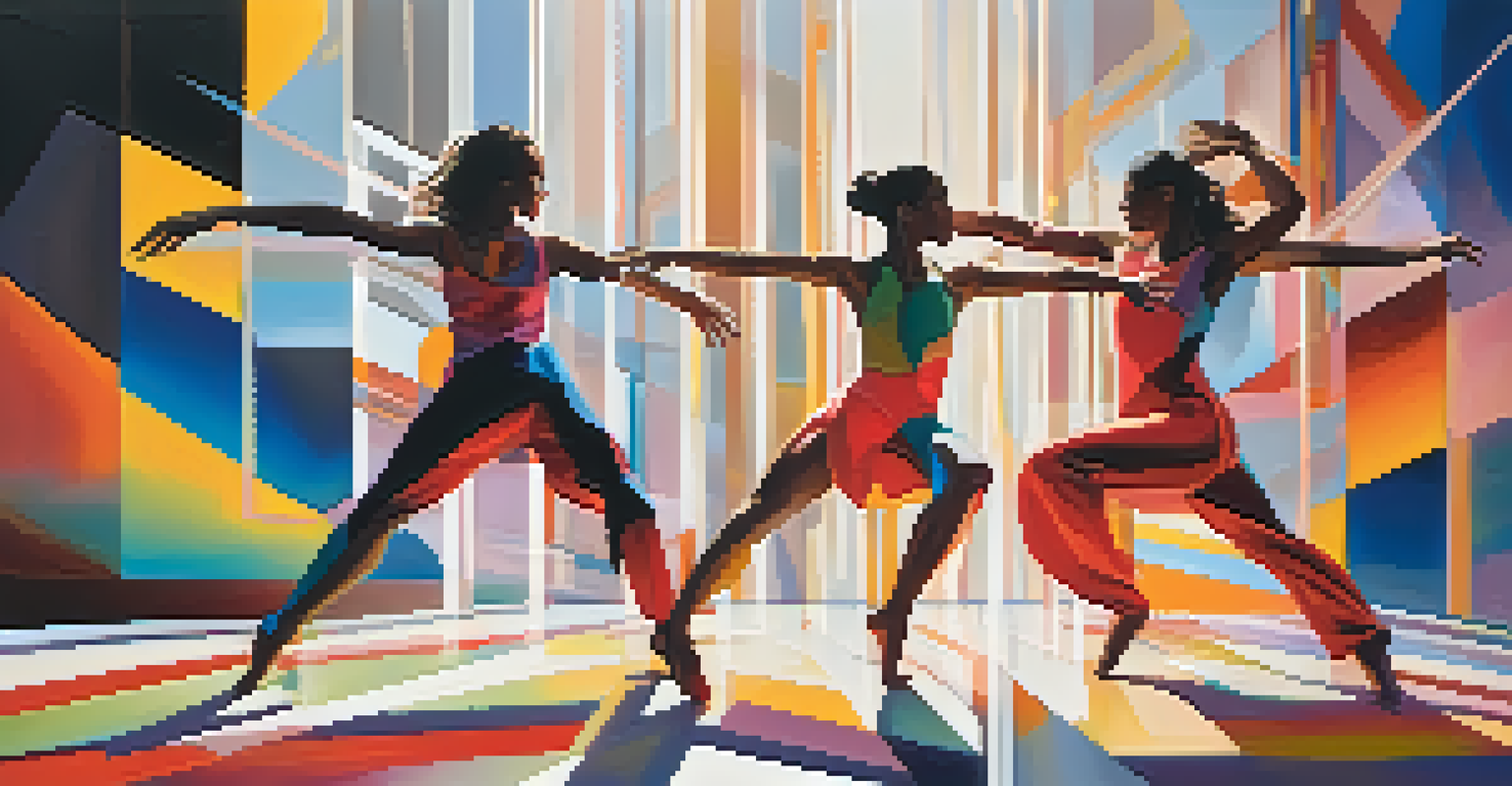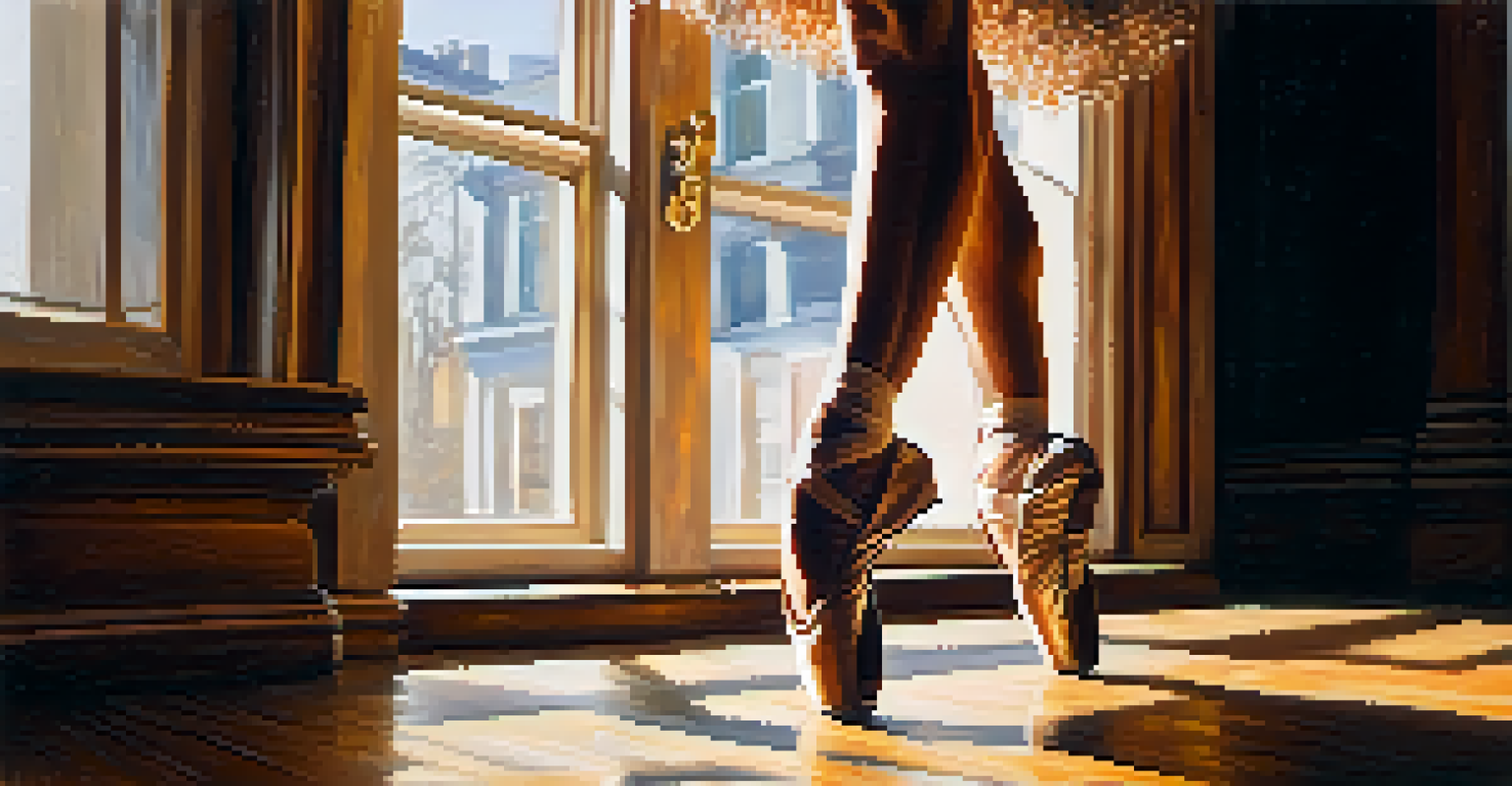Contemporary Dance: Breaking Boundaries with New Styles

What is Contemporary Dance? A Brief Overview
Contemporary dance is a dynamic form of dance that combines various styles and techniques. It emerged in the mid-20th century as a departure from classical ballet, allowing for more freedom of expression and creativity. Dancers often incorporate elements from jazz, hip-hop, and even martial arts, making it a versatile medium for storytelling.
Dance is the hidden language of the soul.
One of the defining features of contemporary dance is its focus on the individual dancer's expression. This means that every performance can be unique, shaped by the dancer's personal experiences and emotions. This personal connection often resonates with audiences, making contemporary dance a powerful art form.
In recent years, contemporary dance has gained popularity across the globe, attracting a diverse audience. Its ability to reflect contemporary issues and emotions has made it a relevant and engaging form of art that continues to evolve.
The Impact of Technology on Contemporary Dance
Technology has played a significant role in shaping contemporary dance, providing new creative avenues for artists. From digital projections to interactive performances, technology allows dancers to explore their craft in innovative ways. For instance, some choreographers use motion capture to analyze and develop their movements further.

Additionally, social media platforms have provided a stage for dancers to showcase their work to a broader audience. Dancers can share their performances with the world, gaining feedback and building a community around their art. This accessibility has also sparked collaborations across different artistic disciplines, creating even more diverse performances.
Expression and Individuality in Dance
Contemporary dance emphasizes the unique expression of each dancer, allowing performances to resonate deeply with audiences.
As technology continues to advance, it will undoubtedly influence the future of contemporary dance. The integration of virtual reality and augmented reality may open up new realms of possibilities, allowing audiences to experience dance in ways that have never been imagined before.
Fusion of Styles: Blending Dance Genres
One of the most exciting aspects of contemporary dance is its ability to blend various dance genres. Dancers often incorporate elements from ballet, jazz, hip-hop, and even traditional cultural dances, creating a rich tapestry of movement. This fusion not only keeps the art form fresh but also allows for creative storytelling that resonates with diverse audiences.
The body says what words cannot.
For example, a contemporary dance piece might start with classical ballet techniques and seamlessly transition into street dance moves. This juxtaposition can highlight the contrast between gracefulness and raw energy, making the performance even more captivating. Such blending of styles challenges the traditional boundaries of dance, inviting audiences to experience something entirely new.
Moreover, this fusion reflects the multicultural society we live in today. By incorporating various dance styles, contemporary dancers can celebrate their heritage while also pushing the envelope of what dance can be.
Exploring Themes: Social Issues in Dance
Contemporary dance often serves as a platform for exploring and addressing social issues. Many choreographers draw inspiration from current events, using their art to comment on topics like identity, mental health, and social justice. This allows the audience to engage with the performance on a deeper level, prompting reflection and discussion.
For instance, a dance piece might tackle the theme of climate change, with movements symbolizing the struggle between nature and industrialization. Through the use of symbolism and expressive movement, dancers can convey powerful messages that resonate with viewers long after the performance ends. This ability to provoke thought is one of the hallmarks of contemporary dance.
Technology's Role in Dance Evolution
The integration of technology in contemporary dance introduces innovative creative avenues, enhancing performances and audience engagement.
By using the body as a canvas for storytelling, contemporary dance helps to raise awareness about pressing societal issues. It encourages audiences to think critically about the world around them and sparks conversations that can lead to change.
The Role of Improvisation in Contemporary Dance
Improvisation is a core element of contemporary dance that allows for spontaneity and personal expression. Dancers often engage in improvisational exercises to explore their movement vocabulary and discover new ways of expressing themselves. This practice can lead to unexpected and exciting outcomes during performances.
For many dancers, improvisation is not just a creative tool but a way to connect with their bodies and emotions. By letting go of preconceived notions about movement, dancers can tap into their instincts and create something truly unique. This element of surprise not only keeps the audience engaged but also fosters a genuine connection between the performer and the viewer.
Moreover, improvisation can serve as a collaborative process in group settings, where dancers build off each other's movements and ideas. This organic collaboration encourages a sense of community and shared creativity, making performances feel alive and dynamic.
Notable Contemporary Dance Companies and Their Influence
Several contemporary dance companies have made significant contributions to the evolution of the art form. For example, the Alvin Ailey American Dance Theater has been pivotal in showcasing African American culture through dance, blending contemporary techniques with traditional African dance styles. Their performances have inspired countless dancers and choreographers around the world.
Another influential company is the Merce Cunningham Dance Company, known for its avant-garde approach and experimentation with movement. By collaborating with visual artists and musicians, Cunningham challenged conventional norms and expanded the boundaries of contemporary dance. His legacy continues to inspire modern choreographers who seek to innovate and redefine the art form.
Fusing Dance Styles for Storytelling
Contemporary dance thrives on blending various genres, creating dynamic performances that reflect our multicultural society.
These companies not only push the envelope in terms of technique and style but also help to elevate the status of contemporary dance in the broader arts community. Their commitment to creativity and exploration encourages emerging artists to take risks and think outside the box.
The Future of Contemporary Dance: Trends and Predictions
As contemporary dance continues to evolve, several trends are emerging that may shape its future. One trend is the increasing emphasis on inclusivity, with more dancers from diverse backgrounds sharing their stories and perspectives through movement. This shift is enriching the art form and expanding its reach to wider audiences.
Additionally, the use of technology in dance is likely to grow, with more choreographers experimenting with multimedia elements. As virtual reality and augmented reality become more accessible, we may see immersive dance experiences that blur the lines between performance and audience participation. This could open up entirely new ways to experience and engage with dance.

Ultimately, the future of contemporary dance holds exciting possibilities. As artists continue to break boundaries and explore new styles, we can expect to see a vibrant and ever-evolving landscape that reflects the complexities of our world.